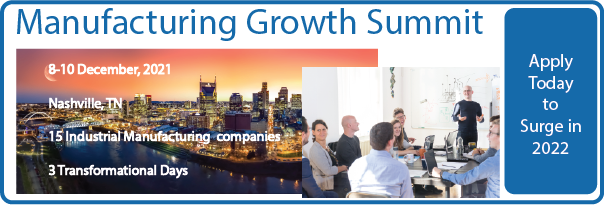OEE helps improve your manufacturing. ORE™ can do the same for your revenue growth
Introduction to SignalsFromTheOP
Guide to episode
- There's a stark difference between how companies manage their manufacturing vs. their revenue growth.
- ORE or Overall Revenue Effectiveness is a revenue growth analog to OEE for production effectiveness.
- We can build the same sequence of steps, understand dependencies, and optimize each individually and in aggregate.
- This ORE model will help manufacturers adapt to today's challenging markets.
Transcript follows
Hi, I’m Ed Marsh. Welcome to this episode of Signals from the OP. An OP, or observation post, is a spot out ahead of the lines, beyond the noise and light, which provides early warning of enemy activity. I use that analogy because the goal of these videos is to provide early warning of changes that will impact companies in the industrial manufacturing space.
Today we’re going to chat about a dissonance. A dissonance that exists between how manufacturers run their production vs their revenue growth. And I’m going to share a new concept that I’m really excited about.
OEE or overall equipment effectiveness is a basic approach that’s used to improve and optimize manufacturing. The concept is simple. The cumulative output of a manufacturing operation is the product of each step along the way.
Downtime for break-fix, changeovers, or material flow are factored in, along with quality. And the cumulative impact can often be alarming. If you have a number of steps – let’s say 10 - which each run at what seems like a darn near perfect 98% efficiency, the net OEE of that plunges to less than 82%. That means you’re only producing quality product for 6 hours of a typical 8-hour shift with half-hour lunch. And if one step is only 85% efficient, the whole thing tumbles to 70% overall.
So, where am I going with this?
It’s simple. We need to bring the same rigor to revenue growth. We need to understand all the steps - from first attracting a prospect through a repeat order - and apply the same methodology that’s so dramatically improved manufacturing over recent decades.
Let me just warn you – buckle up. In the revenue space, we’re not talking 98% efficient steps. Here are some examples.
• Typical click-through rates on organic search are 2-5%
• Site visitor to lead conversion rates are 3%
• Of all deals, 38% end in no decision – meaning only 62% move through
• Win/loss rates are great when a sales team closes 33% of their qualified, quoted, expect to close deals
You can see where this is going.
The overall effectiveness of revenue growth – I’m calling it ORE – is abysmal. And we all see the symptoms. Particularly Unpredictable revenue and wildly inaccurate forecasting.
OK. Let’s back up. Think about how production used to be managed. When you had a quality problem, you’d hire a couple of inspectors for the end of the line to make sure bad parts didn’t ship. In our sales context, that’s analogous to today’s “opportunity review” where we huddle in hopes of pulling rabbits out of hats.
The production solution built on OEE was to look at the full process and incrementally improve, or even change, each step along the way. Preventative maintenance, jigs, and fixtures, raw material inputs, process flow, training, even ergonomics, and lighting are all tools to improve a step. And all work toward putting more quality products out the door.
Each of those steps has analogs in marketing and sales too. And all these need to work toward improving the buyer's experience. The science and the art are both critical – in a contiguous process.
Like to old system of fixing a symptom of quality, Unfortunately, what often happens today in a sales context, is that someone will become infatuated with some software, tactic, or training and vigorously apply it to a single step in the process without the context of the entire revenue growth process. And the net result is that there’s disruption, investment of resources, and no sense of whether the entire process – engaged buyers moving toward decisions that deliver the best outcomes for them – is improved.
But when we think of ORE like OEE, and consider ALL of the steps through the buying process, and inefficiency in each, you can easily see why the outcomes – revenue and forecasting are so unreliable.
Now, I get it. This feels like something too big to tackle. How could one possibly begin to manage this? After all, aren’t people harder to work with than machines?
This is exactly what everyone said to Deming.
The solution isn’t easy or simple. But it is clear. It’s to think of the entire revenue growth process as a contiguous set of interconnected functions. And to improve the overall process through a combination of high-level thought and focused tactical improvement.
That’s why I’m so excited about the Manufacturing Growth Summit this December. It’s an opportunity for the senior revenue leaders (exec, sales, and marketing) from 15 companies to come together for an intensive 3 days to do the high-level thinking and to create an integrated framework that will enable them to evaluate and implement tactics effectively.
If you’re interested in learning more, go to manufacturing growth summit dot com.
And if this ORE – or overall revenue effectiveness – idea resonates, I’d welcome a discussion.
I’m Ed Marsh. Thank you for joining me for this episode of Signals from the OP. If you enjoyed it, please share it and subscribe – either to my YouTube channel EdMarshSpeaks.TV or at the related blog SignalsFromTheOP.com.

